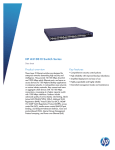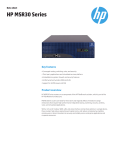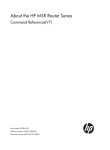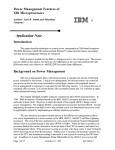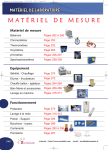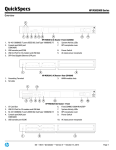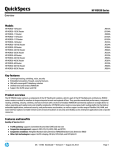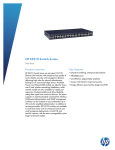Download Hewlett Packard Enterprise MSR1003-8 Ethernet LAN
Transcript
Data sheet HP MSR1000 Router Series Key features •Up to 500 Kpps IP forwarding; converged high-performance routing, switching, security, voice, and mobility •Embedded security features with hardware-based encryption, firewall, network address translation (NAT), and VPNs •Industry-leading breadth of LAN and WAN connectivity options •No additional licensing complexity; no cost for advanced features •Zero-touch solution, with single-pane-of-glass management Product overview The HP MSR1000 Router Series is a next generation multiservices router designed to deliver unmatched application performance for small branch offices. The MSR1000 series provides a flexible multiservice end point for small branches and remote offices that quickly adapts to changing business requirements while delivering integrated, concurrent services on a single, easy-to-manage platform. Features and benefits Performance •Excellent forwarding performance Provides forwarding performance up to 500 Kpps; meets current and future bandwidthintensive application demands of enterprise businesses •Powerful encryption capacity Includes embedded hardware encryption accelerator to improve encryption performance Data sheet | HP MSR1000 Router Series Product architecture •Ideal multiservice platform Provides WAN router, Ethernet switch, wireless LAN, 3G or 4G WAN, firewall, VPN, and SIP or voice gateway all in one box •High-density voice interfaces Provide flexible analog voice interface options for easy integration within a wide range of deployments •USB interface Uses USB memory disk to download and upload configuration files; supports an external USB 3G modem for a 3G WAN uplink •Advanced hardware architecture Delivers Gigabit Ethernet switching and a PCIe bus Connectivity •Packet storm protection Protects against broadcast, multicast, or unicast storms with user-defined thresholds •Loopback Supports internal loopback testing for maintenance purposes and an increase in availability; loopback detection protects against incorrect cabling or network configurations and can be enabled on a per-port or per-VLAN basis for added flexibility •3G/4G access support Provides 3G/4G LTE wireless access for primary or backup connectivity via a 3G/4G LTE SIC modules certified on various cellular networks; optional carrier 3G/4G USB modems available •Flexible port selection Provides a combination of fiber and copper interface modules, 100/1000BASE-X auto-speed selection, and 10/100/1000BASE-T auto-speed detection plus auto duplex and MDI/MDI-X •Multiple WAN interfaces Provide a traditional link with E1, T1, ADSL, ADSL2, ADSL2+, G.SHDSL, Serial, and ISDN backup; provide high-density Ethernet access with Fast Ethernet/Gigabit Ethernet, mobility access with IEEE 802.11b/g/n Wi-Fi, and 3G/4G LTE options •High-density port connectivity Integrates four or eight Giga LAN switching ports (All switching ports can be configured as routed ports.), two or three SIC slots, and up to 30 module options Layer 2 switching •Spanning Tree Protocol (STP) Supports standard IEEE 802.1D STP, IEEE 802.1w Rapid Spanning Tree Protocol (RSTP) for faster convergence, and IEEE 802.1s Multiple Spanning Tree Protocol (MSTP) •Internet Group Management Protocol (IGMP) and Multicast Listener Discovery (MLD) protocol snooping Control and manage the flooding of multicast packets in a Layer 2 network •Port mirroring Duplicates port traffic (ingress and egress) to a local or remote monitoring port •VLANs Support IEEE 802.1Q-based VLANs 2 Data sheet | HP MSR1000 Router Series •sFlow Allows traffic sampling •Define port as switched or routed Supports command switch to easily change switched ports to routed (maximum eight GE ports) Layer 3 routing •Static IPv4 routing Provides simple manually configured IPv4 routing •Routing Information Protocol (RIP) Uses a distance vector algorithm with User Datagram Protocol (UDP) packets for route determination; supports RIPv1 and RIPv2 routing; includes loop protection •Open Shortest Path First (OSPF) Delivers faster convergence; uses this link-state routing Interior Gateway Protocol (IGP), which supports ECMP, NSSA, and MD5 authentication for increased security and graceful restart for faster failure recovery •Border Gateway Protocol 4 (BGP-4) Delivers an implementation of the Exterior Gateway Protocol (EGP) utilizing path vectors; uses TCP for enhanced reliability for the route discovery process; reduces bandwidth consumption by advertising only incremental updates; supports extensive policies for increased flexibility; scales to very large networks •Intermediate system to intermediate system (IS-IS) Uses a path vector Interior Gateway Protocol (IGP), which is defined by the ISO organization for IS-IS routing and extended by IETF RFC 1195 to operate in both TCP/IP and the OSI reference model (Integrated IS-IS) •Static IPv6 routing Provides simple manually configured IPv6 routing •Dual IP stack Maintains separate stacks for IPv4 and IPv6 to ease the transition from an IPv4-only network to an IPv6-only network design •Routing Information Protocol next generation (RIPng) Extends RIPv2 to support IPv6 addressing •OSPFv3 Provides OSPF support for IPv6 •BGP+ Extends BGP-4 to support Multiprotocol BGP (MP-BGP), including support for IPv6 addressing •IS-IS for IPv6 Extends IS-IS to support IPv6 addressing •IPv6 tunneling Allows IPv6 packets to traverse IPv4-only networks by encapsulating the IPv6 packet into a standard IPv4 packet; supports manually configured, 6 to 4, and Intra-Site Automatic Tunnel Addressing Protocol (ISATAP) tunnels; is an important element for the transition from IPv4 to IPv6 3 Data sheet | HP MSR1000 Router Series •Multiprotocol Label Switching (MPLS) Uses BGP to advertise routes across Label Switched Paths (LSPs), but uses simple labels to forward packets from any Layer 2 or Layer 3 protocol, which reduces complexity and increases performance; supports graceful restart for reduced failure impact; supports LSP tunneling and multilevel stacks •Multiprotocol Label Switching (MPLS) Layer 3 VPN Allows Layer 3 VPNs across a provider network; uses Multiprotocol BGP (MP-BGP) to establish private routes for increased security; supports RFC 2547 multiple autonomous system VPNs for added flexibility; supports IPv6 MPLS VPN •Multiprotocol Label Switching (MPLS) Layer 2 VPN Establishes simple Layer 2 point-to-point VPNs across a provider network using only MPLS Label Distribution Protocol (LDP); requires no routing and therefore decreases complexity, increases performance, and allows VPNs of non-routable protocols; uses no routing information for increased security; supports Circuit Cross Connect (CCC), Static Virtual Circuits (SVCs), Martini draft, and Kompella draft technologies •Policy routing Allows custom filters for increased performance and security; supports access control lists (ACLs), IP prefix, AS paths, community lists, and aggregate policies Layer 3 services •Address Resolution Protocol (ARP) Determines the MAC address of another IP host in the same subnet; supports static ARPs; gratuitous ARP allows detection of duplicate IP addresses; proxy ARP allows normal ARP operation between subnets or when subnets are separated by a Layer 2 network •User Datagram Protocol (UDP) helper Redirects UDP broadcasts to specific IP subnets to prevent server spoofing •Dynamic Host Configuration Protocol (DHCP) Simplifies the management of large IP networks and supports client and server; DHCP Relay enables DHCP operation across subnets Quality of service (QoS) •Traffic policing Supports Committed Access Rate (CAR) and line rate •Congestion management Supports FIFO, PQ, CQ, WFQ, CBQ, and RTPQ •Weighted random early detection (WRED)/Random early detection (RED) Delivers congestion avoidance capabilities through the use of queue management algorithms •Other QoS technologies Support traffic shaping, FR QoS, MPLS QoS, and MP QoS/LFI Security •Auto Discover VPN (ADVPN) Collects, maintains, and distributes dynamic public addresses through the VPN Address Management (VAM) protocol, making VPN establishment available between enterprise branches that use dynamic addresses to access the public network; compared to traditional VPN technologies, ADVPN technology is more flexible and has richer features, such as NAT traversal of ADVPN packets, AAA identity authentication, IPSec protection of data packets, and multiple VPN domains 4 Data sheet | HP MSR1000 Router Series •Access control list (ACL) Supports powerful ACLs for both IPv4 and IPv6; ACLs are used for filtering traffic to prevent unauthorized users from accessing the network, or for controlling network traffic to save resources; rules can either deny or permit traffic to be forwarded; rules can be based on a Layer 2 header or a Layer 3 protocol header; rules can be set to operate on specific dates or times •Terminal Access Controller Access-Control System (TACACS+) Delivers an authentication tool using TCP with encryption of the full authentication request, providing additional security •Network login Standard IEEE 802.1x allows authentication of multiple users per port •RADIUS Eases security access administration by using a password authentication server •Network address translation (NAT) Supports one-to-one NAT, many-to-many NAT, and NAT control, enabling NAT-PT to support multiple connections; supports blacklist in NAT/NAT-PT, and a limit on the number of connections, session logs, and multi-instances •Secure shell (SSHv2) Uses external servers to securely login to a remote device or securely login to MSR from a remote location; with authentication and encryption, it protects against IP spoofing and plain text password interception; increases the security of Secure File Transfer Protocol (SFTP) transfers •Unicast Reverse Path Forwarding (URPF) Allows normal packets to be forwarded correctly, but discards the attaching packet due to lack of reverse path route or incorrect inbound interface; prevents source spoofing and distributed attacks •IPSec VPN supports DES, Triple DES (3DES), and Advanced Encryption Standard (AES) 128/192/256 encryption, and MD5 and SHA-1 authentication •Attack detection and protection Responding to network attacks and threats by MSR Comware, support max connection limitation, single-packet attacks protection, scanning attack protection, flood attack protection, TCP and ICMP Attack Protection and so on Convergence •Internet Group Management Protocol (IGMP) Utilizes Any-Source Multicast (ASM) or Source-Specific Multicast (SSM) to manage IPv4 multicast networks; supports IGMPv1, v2, and v3 •Protocol Independent Multicast (PIM) Defines modes of Internet IPv4 and IPv6 multicasting to allow one-to-many and many-tomany transmission of information; supports PIM Dense Mode (DM), Sparse Mode (SM), and Source-Specific Multicast (SSM) 5 Data sheet | HP MSR1000 Router Series •Multicast Source Discovery Protocol (MSDP) Allows multiple PIM-SM domains to interoperate; is used for interdomain multicast applications •Multicast Border Gateway Protocol (MBGP) Allows multicast traffic to be forwarded across BGP networks and kept separate from unicast traffic Integration •Embedded NetStream Improves traffic distribution using powerful scheduling algorithms, including Layer 4 to 7 services; monitors the health status of servers and firewalls •Embedded VPN and stateful firewall Provide enhanced stateful packet inspection and filtering; deliver advanced VPN services with Triple DES (3DES) and Advanced Encryption Standard (AES) encryption at high performance and low latency, and application prioritization and enhancement Resiliency and high availability •Backup center Acts as a part of the management and backup function to provide backup for device interfaces; delivers reliability by switching traffic over to a backup interface when the primary one fails •Virtual Router Redundancy Protocol (VRRP) Allows groups of two routers to dynamically back each other up to create highly available routed environments; supports VRRP load balancing Management •Ease of deployment Zero-touch deployment, supports TR-069, USB disk auto deployment and 3G SMS auto deployment •Industry-standard CLI with a hierarchical structure Reduces training time and expenses, and increases productivity in multivendor installations •Management security Restricts access to critical configuration commands; offers multiple privilege levels with password protection; ACLs provide Telnet and SNMP access; local and remote syslog capabilities allow logging of all access •SNMPv1, v2, and v3 Provide complete support of SNMP; provide full support of industry-standard Management Information Base (MIB) plus private extensions; SNMPv3 supports increased security using encryption •Remote monitoring (RMON) Uses standard SNMP to monitor essential network functions; supports events, alarm, history, and statistics group plus a private alarm extension group •FTP, TFTP, and SFTP support Offers different mechanisms for configuration updates; FTP allows bidirectional transfers over a TCP/IP network; trivial FTP (TFTP) is a simpler method using User Datagram Protocol (UDP); Secure File Transfer Protocol (SFTP) runs over an SSH tunnel to provide additional security •Debug and sampler utility Supports ping and traceroute for both IPv4 and IPv6 6 Data sheet | HP MSR1000 Router Series •Network Time Protocol (NTP) Synchronizes timekeeping among distributed time servers and clients; keeps timekeeping consistent among all clock-dependent devices within the network so that the devices can provide diverse applications based on the consistent time •Information center Provides a central repository for system and network information; aggregates all logs, traps, and debugging information generated by the system and maintains them in order of severity; outputs the network information to multiple channels based on user-defined rules •Management interface control Provides management access through modem port and terminal interface; provides access through terminal interface, Telnet, or SSH •Network Quality Analyzer (NQA) Analyzes network performance and service quality by sending test packets, and provides network performance and service quality parameters such as jitter, TCP, or FTP connection delays; allows network manager to determine overall network performance and diagnose and locate network congestion points Additional information •OPEX savings Simplifies and streamlines deployment, management, and training through the use of a common operating system, thereby cutting costs as well as reducing the risk of human errors associated with having to manage multiple operating systems across different platforms and network layers •High reliability Provides a state-of-the-art unified code base •Faster time to market Allows new and custom features to be brought rapidly to market through engineering efficiencies, delivering better initial and ongoing stability •Green initiative support Provides support for RoHS and WEEE regulations Warranty and support •1-year Warranty Advance hardware replacement with next-business-day delivery (available in most countries) •Electronic and telephone support (for 1-year Warranty) Limited electronic and 24x7 telephone support is available from HP for the entire warranty period; to reach our support centers, refer to hp.com/networking/contact-support; for details on the duration of support provided with your product purchase, refer to hp.com/networking/ warrantysummary •Software releases To find software for your product, refer to hp.com/networking/support; for details on the software releases available with your product purchase, refer to hp.com/networking/ warrantysummary 7 Data sheet | HP MSR1000 Router Series HP MSR1000 Router Series Specifications HP MSR1002-4 AC Router (JG875A) HP MSR1003-8 AC Router (JG732A) I/O ports and slots 2 SIC slots, or 1 DSIC slot 1 RJ-45 autosensing 10/100/1000 WAN port 1 SFP fixed Gigabit Ethernet SFP port 4 RJ-45 autosensing 10/100/1000 LAN ports 1 Serial port 3 SIC slots, or 1 DSIC slot, and 1 SIC slot 2 RJ-45 autosensing 10/100/1000 WAN ports 8 RJ-45 autosensing 10/100/1000 LAN ports Additional ports and slots 1 USB 2.0 1 RJ-45 console port to access limited CLI port 1 USB 2.0 1 RJ-45 console port to access limited CLI port AP characteristics Radios (via optional modules) 3G, 4G LTE 3G, 4G LTE Physical characteristics Dimensions Weight 14.17(w) x 11.81(d) x 1.74(h) in (36 x 30 x 4.42 cm) (1U height) 6.83 lb (3.10 kg) 14.17(w) x 11.81(d) x 17.4(h) in (36 x 30 x 44.2 cm) 6.94 lb (3.15 kg) Memory and processor RISC @ 667 MHz, 512 MB DDR3 SDRAM, 256 MB flash RISC @ 667 MHz, 512 MB DDR3 SDRAM, 256 MB flash Mounting and enclosure Desktop or can be mounted in a EIA standard 19-inch telco rack when used with the rack-mount kit in the package. Desktop or can be mounted in a EIA standard 19-inch telco rack when used with the rack-mount kit in the package. Performance Throughput Routing table size Forwarding table size 500 Kpps (64-byte packets) 200000 entries (IPv4), 200000 entries (IPv6) 200000 entries (IPv4), 200000 entries (IPv6) 500 Kpps (64-byte packets) 30000 entries (IPv4), 30000 entries (IPv6) 30000 entries (IPv4), 30000 entries (IPv6) Environment Operating temperature Operating relative humidity Nonoperating/Storage temperature Nonoperating/Storage relative humidity Altitude 32°F to 113°F (0°C to 45°C) 5% to 95%, noncondensing -40°F to 158°F (-40°C to 70°C) 5% to 95%, noncondensing up to 16,404 ft (5 km) 32°F to 113°F (0°C to 45°C) 5% to 95%, noncondensing -40°F to 158°F (-40°C to 70°C) 5% to 95%, noncondensing up to 16,404 ft (5 km) 8 Data sheet | HP MSR1000 Router Series HP MSR1002-4 AC Router (JG875A) HP MSR1003-8 AC Router (JG732A) 50/60 Hz 92 BTU/hr (97.06 kJ/hr) 100 - 240 VAC 30 W 50/60 Hz 65 BTU/hr (68.58 kJ/hr) 100 - 240 VAC 30 W Notes Maximum power rating and maximum heat dissipation are the worst-case theoretical maximum numbers provided for planning the infrastructure with fully loaded PoE (if equipped), 100% traffic, all ports plugged in, and all modules populated. Maximum power rating and maximum heat dissipation are the worst-case theoretical maximum numbers provided for planning the infrastructure with fully loaded PoE (if equipped), 100% traffic, all ports plugged in, and all modules populated. 137.5 137.5 Safety UL 60950-1; IEC 60950-1; EN 60950-1; CAN/CSA-C22.2 No. 60950-1; FDA 21 CFR Subchapter J; AS/NZS 60950-1; GB 4943.1 UL 60950-1; IEC 60950-1; EN 60950-1; CAN/CSA-C22.2 No. 60950-1; FDA 21 CFR Subchapter J; AS/NZS 60950-1; GB 4943.1 Emissions VCCI Class A; EN 55022 Class A; CISPR 22 Class A; EN 55024; ICES003 Class A; EN 300 386; CISPR 24; AS/NZS CISPR 22 Class A; EN 61000-3-2; EN 61000-3-3; FCC (CFR 47, Part 15) Class A VCCI Class A; EN 55022 Class A; CISPR 22 Class A; EN 55024; ICES003 Class A; EN 300 386; CISPR 24; AS/NZS CISPR 22 Class A; EN 61000-3-2; EN 61000-3-3; FCC (CFR 47, Part 15) Class A Telecom FCC part 68; CS-03 FCC part 68; CS-03 Management IMC—Intelligent Management Center; command-line interface; Web browser; out-of-band management (serial RS-232C); outof-band management (DB-9 serial port console); SNMP Manager; Telnet; RMON1; FTP; IEEE 802.3 Ethernet MIB IMC—Intelligent Management Center; command-line interface; Web browser; out-of-band management (serial RS-232C); outof-band management (DB-9 serial port console); SNMP Manager; Telnet; RMON1; FTP; IEEE 802.3 Ethernet MIB Services Refer to the HP website at hp.com/networking/services for details on the service-level descriptions and product numbers. For details about services and response times in your area, please contact your local HP sales office. Refer to the HP website at hp.com/networking/services for details on the service-level descriptions and product numbers. For details about services and response times in your area, please contact your local HP sales office. Electrical characteristics Frequency Maximum heat dissipation AC voltage Maximum power rating Reliability Availability 9 Data sheet | HP MSR1000 Router Series Standards and Protocols (applies to MSR1002-4 in series) BGP RFC 1163 Border Gateway Protocol (BGP) RFC 1267 Border Gateway Protocol 3 (BGP-3) RFC 1657 Definitions of Managed Objects for BGPv4 RFC 1771 BGPv4 RFC 1772 Application of the BGP RFC 1773 Experience with the BGP-4 Protocol RFC 1774 BGP-4 Protocol Analysis RFC 1965 BGP-4 confederations RFC 1997 BGP Communities Attribute RFC 2439 BGP Route Flap Damping RFC 2547 BGP/MPLS VPNs RFC 2796 BGP Route Reflection RFC 2842 Capability Advertisement with BGP-4 RFC 2858 BGP-4 Multi-Protocol Extensions RFC 2918 Route Refresh Capability RFC 3065 Autonomous System Confederations for BGP RFC 3107 Support BGP carry Label for MPLS RFC 3392 Capabilities Advertisement with BGP-4 RFC 4271 A Border Gateway Protocol 4 (BGP-4) RFC 4273 Definitions of Managed Objects for BGP-4 RFC 4274 BGP-4 Protocol Analysis Denial of service protection CPU DoS Protection Rate Limiting by ACLs Device management RFC 1155 Structure and Mgmt Information (SMIv1) RFC 1157 SNMPv1/v2c RFC 1305 NTPv3 RFC 1591 DNS (client) RFC 1902 (SNMPv2) RFC 1908 (SNMP v1/2 Coexistence) RFC 1945 Hypertext Transfer Protocol— HTTP/1.0 RFC 2271 Framework RFC 2573 (SNMPv3 Applications) RFC 2576 (Coexistence between SNMP V1, V2, V3) RFC 2578-2580 SMIv2 RFC 2579 (SMIv2 Text Conventions) RFC 2580 (SMIv2 Conformance) RFC 3416 (SNMP Protocol Operations v2) RFC 3417 (SNMP Transport Mappings) General protocols RFC 768 UDP RFC 783 TFTP Protocol (revision 2) RFC 791 IP RFC 792 ICMP RFC 793 TCP RFC 826 ARP RFC 896 Congestion Control in IP/TCP Internetworks RFC 917 Internet Subnets RFC 925 Multi-LAN Address Resolution RFC 950 Internet Standard Subnetting Procedure RFC 951 BOOTP RFC 959 File Transfer Protocol (FTP) RFC 1027 Proxy ARP RFC 1048 BOOTP (Bootstrap Protocol) vendor information extensions RFC 1058 RIPv1 RFC 1091 Telnet Terminal-Type Option RFC 1093 NSFNET routing architecture RFC 1141 Incremental updating of the Internet checksum RFC 1142 OSI IS-IS Intra-domain Routing Protocol RFC 1166 Internet address used by Internet Protocol (IP) RFC 1191 Path MTU discovery RFC 1195 OSI ISIS for IP and Dual Environments RFC 1213 Management Information Base for Network Management of TCP/IPbased internets RFC 1253 (OSPF v2) RFC 1305 NTPv3 (IPv4 only) RFC 1321 The MD5 Message-Digest Algorithm RFC 3046 DHCP Relay Agent Information Option RFC 3063 MPLS Loop Prevention Mechanism RFC 3137 OSPF Stub Router Advertisement RFC 3168 The Addition of Explicit Congestion Notification (ECN) to IP RFC 3215 LDP State Machine RFC 3246 Expedited Forwarding PHB RFC 3268 Advanced Encryption Standard (AES) Ciphersuites for Transport Layer Security (TLS) RFC 3277 IS-IS Transient Blackhole Avoidance RFC 3279 Algorithms and Identifiers for the Internet X.509 Public Key Infrastructure Certificate and Certificate Revocation List (CRL) Profile RFC 3280 Internet X.509 Public Key Infrastructure Certificate and Certificate Revocation List (CRL) Profile RFC 3319 Dynamic Host Configuration Protocol (DHCPv6) Options for Session Initiation Protocol (SIP) Servers RFC 3359 Reserved Type, Length and Value (TLV) Codepoints in Intermediate System to Intermediate System RFC 3392 Support BGP capabilities advertisement RFC 3443 Time To Live (TTL) Processing in Multi-Protocol Label Switching (MPLS) Networks RFC 3478 Graceful Restart Mechanism for Label Distribution Protocol RFC 4448 Encapsulation Methods for Transport of Ethernet over MPLS Networks RFC 4451 BGP MULTI_EXIT_DISC (MED) Considerations RFC 4486 Subcodes for BGP Cease Notification Message RFC 4541 Considerations for Internet Group Management Protocol (IGMP) and Multicast Listener Discovery (MLD) Snooping Switches RFC 4553 Structure-Agnostic Time Division Multiplexing (TDM) over Packet (SAToP) RFC 4562 MAC-Forced Forwarding: A Method for Subscriber Separation on an Ethernet Access Network RFC 4576 Using a Link State Advertisement (LSA) Options Bit to Prevent Looping in BGP/MPLS IP Virtual Private Networks (VPNs) RFC 4577 OSPF as the Provider/Customer Edge Protocol for BGP/MPLS IP Virtual Private Networks (VPNs) RFC 4594 Configuration Guidelines for DiffServ Service Classes RFC 4601 Protocol Independent Multicast - Sparse Mode (PIM-SM): Protocol Specification (Revised) RFC 4618 Encapsulation Methods for Transport of PPP/High-Level Data Link Control (HDLC) over MPLS Networks RFC 4619 Encapsulation Methods for Transport of Frame Relay over Multiprotocol Label Switching (MPLS) Networks 10 RFC 4275 BGP-4 MIB Implementation Survey RFC 4276 BGP-4 Implementation Report RFC 4277 Experience with the BGP-4 Protocol RFC 4360 BGP Extended Communities Attribute RFC 4456 BGP Route Reflection: An Alternative to Full Mesh Internal BGP (IBGP) RFC 4724 Graceful Restart Mechanism for BGP RFC 4760 Multiprotocol Extensions for BGP-4 RFC1998 An Application of the BGP Community Attribute in Multi-home Routing Data sheet | HP MSR1000 Router Series Standards and Protocols (applies to MSR1002-4 in series) General protocols RFC 1323 TCP Extensions for High Performance RFC 1349 Type of Service RFC 1350 TFTP Protocol (revision 2) RFC 1449 Transport Mappings for version 2 of the Simple Network Management Protocol (SNMPv2) RFC 1519 CIDR RFC 1542 BOOTP Extensions RFC 1542 Clarifications and Extensions for the Bootstrap Protocol RFC 1624 Incremental Internet Checksum RFC 1631 NAT RFC 1701 Generic Routing Encapsulation RFC 1702 Generic Routing Encapsulation over IPv4 networks RFC 1721 RIP-2 Analysis RFC 1722 RIP-2 Applicability RFC 1723 RIP v2 RFC 1724 RIP Version 2 MIB Extension RFC 1777 Lightweight Directory Access Protocol RFC 1812 IPv4 Routing RFC 1825 Security Architecture for the Internet Protocol RFC 1826 IP Authentication Header RFC 1827 IP Encapsulating Security Payload (ESP) RFC 1829 The ESP DES-CBC Transform RFC 1945 Hypertext Transfer Protocol— HTTP/1.0 RFC 1966 BGP Route Reflection An alternative to full mesh IBGP RFC 1981 Path MTU Discovery for IP version 6 RFC 2003 IP Encapsulation within IP RFC 2018 TCP Selective Acknowledgement Options RFC 2082 RIP-2 MD5 Authentication RFC 2104 HMAC: Keyed-Hashing for Message Authentication RFC 2131 DHCP RFC 2132 DHCP Options and BOOTP Vendor Extensions RFC 2138 Remote Authentication Dial In User Service (RADIUS) RFC 2236 IGMP Snooping RFC 2246 The TLS Protocol Version 1.0 RFC 2251 Lightweight Directory Access Protocol (v3) RFC 2252 Lightweight Directory Access Protocol (v3): Attribute Syntax Definitions RFC 2283 MBGP RFC 2309 Recommendations on queue management and congestion avoidance in the Internet RFC 2338 VRRP RFC 2451 The ESP CBC-Mode Cipher Algorithms RFC 2453 RIPv2 RFC 2474 Definition of the Differentiated Services Field (DS Field) in the IPv4 and IPv6 Headers RFC 3479 Fault Tolerance for the Label Distribution Protocol (LDP) RFC 3509 OSPF ABR Behavior RFC 3526 More Modular Exponential (MODP) Diffie-Hellman groups for Internet Key Exchange (IKE) RFC 3564 Requirements for Support of Differentiated Services-aware MPLS Traffic Engineering RFC 3567 Intermediate System to Intermediate System (IS-IS) Cryptographic Authentication RFC 3584 Coexistence between Version 1 and Version 2 of the Internet-standard Network Management Framework RFC 3602 The AES-CBC Cipher Algorithm and Its Use with IPSec RFC 3612 Applicability Statement for Restart Mechanisms for the Label Distribution Protocol (LDP) RFC 3623 Graceful OSPF Restart RFC 3646 DNS Configuration options for Dynamic Host Configuration Protocol for IPv6 (DHCPv6) RFC 3662 A Lower Effort Per-Domain Behavior (PDB) for Differentiated Services RFC 3704 Unicast Reverse Path Forwarding (URPF) RFC 3706 A Traffic-Based Method of Detecting Dead Internet Key Exchange (IKE) Peers RFC 3719 Recommendations for Interoperable Networks using Intermediate System to Intermediate System (IS-IS) RFC 3736 Stateless Dynamic Host Configuration Protocol (DHCP) Service for IPv6 RFC 3768 Virtual Router Redundancy Protocol (VRRP) RFC 3782 The NewReno Modification to TCP’s Fast Recovery Algorithm RFC 3786 Extending the Number of IS-IS LSP Fragments Beyond the 256 Limit RFC 3787 Recommendations for Interoperable IP Networks using Intermediate System to Intermediate System (IS-IS) RFC 3810 Multicast Listener Discovery Version 2 (MLDv2) for IPv6 RFC 3812 Multiprotocol Label Switching (MPLS) Traffic Engineering (TE) Management Information Base (MIB) RFC 3815 Definitions of Managed Objects for the Multiprotocol Label Switching (MPLS), Label Distribution Protocol (LDP) RFC 3847 Restart signaling for IS-IS RFC 3916 Requirements for Pseudo-Wire Emulation Edge-to-Edge (PWE3) RFC 3948 UDP Encapsulation of IPsec ESP Packets RFC 3973 Protocol Independent Multicast - Dense Mode (PIM-DM): Protocol Specification (Revised) RFC 4632 Classless Inter-domain Routing (CIDR): The Internet Address Assignment and Aggregation Plan RFC 4659 BGP-MPLS IP Virtual Private Network (VPN) Extension for IPv6 VPN RFC 4664 Framework for Layer 2 Virtual Private Networks (L2VPNs) RFC 4665 Service Requirements for Layer 2 Provider-Provisioned Virtual Private Networks RFC 4741 NETCONF Configuration Protocol RFC 4742 Using the NETCONF Configuration Protocol over Secure SHell (SSH) RFC 4743 Using NETCONF over the Simple Object Access Protocol (SOAP) RFC 4765 Service Requirements for Layer 2 Provider Provisioned Virtual Private Networks RFC 4781 Graceful Restart Mechanism for BGP with MPLS RFC 4787 Network Address Translation (NAT) Behavioral Requirements for Unicast UDP RFC 4798 Connecting IPv6 Islands over IPv4 MPLS Using IPv6 Provider Edge Routers (6PE) RFC 4811 OSPF Out-of-Band Link State Database (LSDB) Resynchronization RFC 4812 OSPF Restart Signaling RFC 4813 OSPF Link-Local Signaling RFC 4816 Pseudowire Emulation Edgeto-Edge (PWE3) Asynchronous Transfer Mode (ATM) Transparent Cell Transport Service RFC 4835 Cryptographic Algorithm Implementation Requirements for Encapsulating Security Payload (ESP) and Authentication Header (AH) RFC 4861 Neighbor Discovery for IP version 6 (IPv6) RFC 4862 IPv6 Stateless Address Autoconfiguration RFC 4878 “Definitions and Managed Objects for Operations, Administration, and Maintenance (OAM) Functions on RFC 4893 BGP Support for Four-octet AS Number Space RFC 4940 IANA Considerations for OSPF RFC 4941 Privacy Extensions for Stateless Address Autoconfiguration in IPv6 RFC 5007 DHCPv6 Leasequery RFC 5036 LDP Specification RFC 5065 Autonomous System Confederations for BGP RFC 5086 Structure-Aware Time Division Multiplexed (TDM) Circuit Emulation Service over Packet Switched Network (CESoPSN) RFC 5095 Deprecation of Type 0 Routing Headers in IPv6 RFC 5130 A Policy Control Mechanism in IS-IS Using Administrative Tags 11 Data sheet | HP MSR1000 Router Series Standards and Protocols (applies to MSR1002-4 in series) General protocols 12 RFC 2510 Internet X.509 Public Key Infrastructure Certificate Management Protocols RFC 2519 A Framework for Inter-Domain Route Aggregation RFC 2529 Transmission of IPv6 over IPv4 Domains without Explicit Tunnels RFC 2548 (MS-RAS-Vendor only) RFC 2581 TCP Congestion Control RFC 2597 Assured Forwarding PHB Group RFC 2598 An Expedited Forwarding PHB RFC 2616 HTTP Compatibility v1.1 RFC 2661 L2TP RFC 2663 NAT Terminology and Considerations RFC 2694 DNS extensions to Network Address Translators (DNS_ALG) RFC 2698 A Two Rate Three Color Marker RFC 2716 PPP EAP TLS Authentication Protocol RFC 2747 RSVP Cryptographic Authentication RFC 2763 Dynamic Name-to-System ID mapping RFC 2784 Generic Routing Encapsulation (GRE) RFC 2827 Network Ingress Filtering: Defeating Denial of Service Attacks Which Employ IP Source Address Spoofing RFC 2865 Remote Authentication Dial In User Service (RADIUS) RFC 2866 RADIUS Accounting RFC 2868 RADIUS Attributes for Tunnel Protocol Support RFC 2869 RADIUS Extensions RFC 2884 Performance Evaluation of Explicit Congestion Notification (ECN) in IP Networks. RFC 2963 A Rate Adaptive Shaper for Differentiated Services RFC 2966 Domain-wide Prefix Distribution with Two-Level IS-IS RFC 2973 IS-IS Mesh Groups RFC 2993 Architectural Implications of NAT RFC 3011 The IPv4 Subnet Selection Option for DHCP RFC 3022 Traditional IP Network Address Translator (Traditional NAT) RFC 3027 Protocol Complications with the IP Network Address Translator RFC 3031 Multiprotocol Label Switching Architecture RFC 3032 MPLS Label Stack Encoding RFC 3036 LDP Specification RFC 3037 LDP (Label Distribution Protocol) Applicability RFC 3985 Pseudo Wire Emulation Edgeto-Edge (PWE3) Architecture RFC 4061 Benchmarking Basic OSPF Single Router Control Plane Convergence RFC 4062 OSPF Benchmarking Terminology and Concepts RFC 4063 Considerations When Using Basic OSPF Convergence Benchmarks RFC 4109 Algorithms for Internet Key Exchange version 1 (IKEv1) RFC 4133 Entity MIB (Version 3) RFC 4182 Removing a Restriction on the use of MPLS Explicit NULL RFC 4214 Intra-Site Automatic Tunnel Addressing Protocol (ISATAP) RFC 4222 Prioritized Treatment of Specific OSPF Version 2 Packets and Congestion Avoidance RFC 4250 The Secure Shell (SSH) Protocol Assigned Numbers RFC 4251 The Secure Shell (SSH) Protocol Architecture RFC 4252 The Secure Shell (SSH) Authentication Protocol RFC 4253 The Secure Shell (SSH) Transport Layer Protocol RFC 4254 The Secure Shell (SSH) Connection Protocol RFC 4291 IP Version 6 Addressing Architecture RFC 4305 Cryptographic Algorithm Implementation Requirements for Encapsulating Security Payload (ESP) and Authentication Header (AH) RFC 4364 BGP/MPLS IP Virtual Private Networks (VPNs) RFC 4365 Applicability Statement for BGP/MPLS IP Virtual Private Networks (VPNs) RFC 4381 Analyses of the Security of BGP/MPLS IP VPNs RFC 4382 MPLS/BGP Layer 3 Virtual Private Network (VPN) Management Information Base RFC 4385 Pseudowire Emulation Edgeto-Edge (PWE3) Control Word for Use over an MPLS PSN RFC 4419 Diffie-Hellman Group Exchange for the Secure Shell (SSH) Transport Layer Protocol RFC 4446 IANA Allocations for Pseudowire Edge to Edge Emulation (PWE3) RFC 4447 Pseudowire Setup and Maintenance Using the Label Distribution Protocol (LDP) RFC 5187 OSPFv3 Graceful Restart RFC 5214 Intra-Site Automatic Tunnel Addressing Protocol (ISATAP) RFC 5254 Requirements for MultiSegment Pseudowire Emulation Edgeto-Edge (PWE3) RFC 5277 NETCONF Event Notifications RFC 5280 Internet X.509 Public Key Infrastructure Certificate and Certificate Revocation List (CRL) Profile RFC 5286 Basic Specification for IP Fast Reroute: Loop-Free Alternates RFC 5287 Control Protocol Extensions for the Setup of Time-Division Multiplexing (TDM) Pseudowires in MPLS Networks RFC 5301 Dynamic Hostname Exchange Mechanism for IS-IS RFC 5302 Domain-Wide Prefix Distribution with Two-Level IS-IS RFC 5304 Intermediate System to Intermediate System (IS-IS) Cryptographic Authentication RFC 5306 Restart Signaling for IS-IS RFC 5308 Routing IPv6 with IS-IS RFC 5309 Point-to-Point Operation over LAN in Link State Routing Protocols RFC 5381 Experience of Implementing NETCONF over SOAP RFC 5382 The IP Network Address Translator (NAT) RFC 5398 Autonomous System (AS) Number Reservation for Documentation Use RFC 5492 Capabilities Advertisement with BGP-4 RFC 5508 NAT Behavioral Requirements for ICMP RFC 5539 NETCONF over Transport Layer Security (TLS) RFC 5613 OSPF Link-Local Signaling RFC 5659 An Architecture for MultiSegment Pseudowire Emulation Edgeto-Edge RFC 5798 Virtual Router Redundancy Protocol (VRRP) Version 3 for IPv4 and IPv6 RFC 5880 Bidirectional Forwarding Detection RFC 5881 BFD for IPv4 and IPv6 (Single Hop) RFC 5882 Generic Application of BFD RFC 5883 BFD for Multihop Paths RFC 5905 Network Time Protocol Version 4: Protocol and Algorithms Specification RFC 854 Telnet Protocol Specification RFC 856 Telnet Binary Transmission Data sheet | HP MSR1000 Router Series Standards and Protocols (applies to MSR1002-4 in series) IP multicast RFC 1112 IGMP RFC 2362 PIM Sparse Mode RFC 2710 Multicast Listener Discovery (MLD) for IPv6 RFC 2934 Protocol Independent Multicast MIB for IPv4 RFC 3376 IGMPv3 RFC 3376 IGMPv3 (host joins only) RFC 5059 Bootstrap Router (BSR) Mechanism for Protocol Independent Multicast (PIM) IPv6 RFC 2080 RIPng for IPv6 RFC 2460 IPv6 Specification RFC 2473 Generic Packet Tunneling in IPv6 RFC 2475 IPv6 DiffServ Architecture RFC 2529 Transmission of IPv6 Packets over IPv4 RFC 2545 Use of MP-BGP-4 for IPv6 RFC 2553 Basic Socket Interface Extensions for IPv6 RFC 2740 OSPFv3 for IPv6 RFC 2893 Transition Mechanisms for IPv6 Hosts and Routers RFC 3056 Connection of IPv6 Domains via IPv4 Clouds RFC 3162 RADIUS and IPv6 RFC 3315 DHCPv6 (client and relay) RFC 5340 OSPF for IPv6 MIBs RFC 1213 MIB II RFC 1493 Bridge MIB RFC 1724 RIPv2 MIB RFC 1850 OSPFv2 MIB RFC 1907 SNMPv2 MIB RFC 2011 SNMPv2 MIB for IP RFC 2012 SNMPv2 MIB for TCP RFC 2013 SNMPv2 MIB for UDP RFC 2096 IP Forwarding Table MIB RFC 2233 Interfaces MIB RFC 2273 SNMP-NOTIFICATION-MIB RFC 2571 SNMP Framework MIB RFC 2572 SNMP-MPD MIB RFC 2573 SNMP-Notification MIB RFC 2574 SNMP USM MIB RFC 2674 802.1p and IEEE 802.1Q Bridge MIB RFC 2737 Entity MIB (Version 2) RFC 2863 The Interfaces Group MIB RFC 3813 MPLS LSR MIB Network management IEEE 802.1D (STP) RFC 1098 Simple Network Management Protocol (SNMP) RFC 1158 Management Information Base for network management of TCP/IPbased internets: MIB-II RFC 1212 Concise MIB definitions RFC 1215 Convention for defining traps for use with the SNMP RFC 1389 RIPv2 MIB Extension RFC 1448 Protocol Operations for version 2 of the Simple Network Management Protocol (SNMPv2) RFC 1450 Management Information Base (MIB) for version 2 of the Simple Network Management Protocol (SNMPv2) RFC 1902 Structure of Management Information for Version 2 of the Simple Network Management Protocol (SNMPv2) RFC 1903 SNMPv2 Textual Conventions RFC 1904 SNMPv2 Conformance RFC 1905 SNMPv2 Protocol Operations RFC 1906 SNMPv2 Transport Mappings RFC 1908 Coexistence between Version 1 and Version 2 of the Internet-standard Network Management Framework RFC 1918 Private Internet Address Allocation RFC 2037 Entity MIB using SMIv2 RFC 2261 An Architecture for Describing SNMP Management Frameworks RFC 2262 Message Processing and Dispatching for the Simple Network Management Protocol (SNMP) RFC 2263 SNMPv3 Applications RFC 2264 User-based Security Model (USM) for version 3 of the Simple Network Management Protocol (SNMPv3) RFC 2265 View-based Access Control Model (VACM) for the Simple Network Management Protocol (SNMP) RFC 2272 SNMPv3 Management Protocol RFC 2273 SNMPv3 Applications RFC 2274 USM for SNMPv3 RFC 2275 VACM for SNMPv3 RFC 2575 SNMPv3 View-based Access Control Model (VACM) RFC 3164 BSD syslog Protocol RFC 3411 An Architecture for Describing Simple Network Management Protocol (SNMP) Management Frameworks RFC 3412 Message Processing and Dispatching for the Simple Network Management Protocol (SNMP) RFC 3413 Simple Network Management Protocol (SNMP) Applications RFC 3414 SNMPv3 User-based Security Model (USM) RFC 3415 View-based Access Control Model (VACM) for the Simple Network Management Protocol (SNMP) RFC 3418 Management Information Base (MIB) for the Simple Network Management Protocol (SNMP) 13 Data sheet | HP MSR1000 Router Series Standards and Protocols (applies to MSR1002-4 in series) OSPF RFC 1245 OSPF protocol analysis RFC 1246 Experience with OSPF RFC 1583 OSPFv2 RFC 1587 OSPF NSSA RFC 1765 OSPF Database Overflow RFC 1850 OSPFv2 Management Information Base (MIB), traps RFC 2328 OSPFv2 RFC 2370 OSPF Opaque LSA Option RFC 3101 OSPF NSSA QoS/CoS IEEE 802.1P (CoS) RFC 2474 DS Field in the IPv4 and IPv6 Headers RFC 2475 DiffServ Architecture RFC 2597 DiffServ Assured Forwarding (AF) RFC 2598 DiffServ Expedited Forwarding (EF) RFC 2697 A Single Rate Three Color Marker RFC 3168 The Addition of Explicit Congestion Notification (ECN) to IP RFC 3247 Supplemental Information for the New Definition of the EF PHB (Expedited Forwarding Per-Hop Behavior) RFC 3260 New Terminology and Clarifications for DiffServ Security IEEE 802.1X Port Based Network Access Control RFC 2082 RIP-2 MD5 Authentication RFC 2104 Keyed-Hashing for Message Authentication RFC 2138 RADIUS Authentication RFC 2139 RADIUS Accounting RFC 2408 Internet Security Association and Key Management Protocol (ISAKMP) RFC 2409 The Internet Key Exchange (IKE) RFC 2412 The OAKLEY Key Determination Protocol RFC 2459 Internet X.509 Public Key Infrastructure Certificate and CRL Profile RFC 2818 HTTP Over TLS RFC 2865 RADIUS Authentication RFC 2866 RADIUS Accounting RFC 3579 RADIUS Support For Extensible Authentication Protocol (EAP) RFC 3580 IEEE 802.1X Remote Authentication Dial In User Service (RADIUS) Usage Guidelines VPN RFC 1828 IP Authentication using Keyed MD5 RFC 1853 IP in IP Tunneling RFC 2401 Security Architecture for the Internet Protocol RFC 2402 IP Authentication Header RFC 2403 The Use of HMAC-MD5-96 within ESP and AH RFC 2404 The Use of HMAC-SHA-1-96 within ESP and AH RFC 2405 The ESP DES-CBC Cipher Algorithm With Explicit IV RFC 2406 IP Encapsulating Security Payload (ESP) RFC 2407 The Internet IP Security Domain of Interpretation for ISAKMP RFC 2410 The NULL Encryption Algorithm and Its Use With IPSec RFC 2411 IP Security Document Roadmap RFC 3948 - UDP Encapsulation of IPSec ESP Packets RFC 4301 - Security Architecture for the Internet Protocol RFC 4302 - IP Authentication Header (AH) RFC 4303 - IP Encapsulating Security Payload (ESP) RFC 4305 - Cryptographic Algorithm Implementation Requirements for ESP and AH 14 Data sheet | HP MSR1000 Router Series Standards and Protocols (applies to MSR1003-8 in series) BGP RFC 1163 Border Gateway Protocol (BGP) RFC 1267 Border Gateway Protocol 3 (BGP-3) RFC 1657 Definitions of Managed Objects for BGPv4 RFC 1771 BGPv4 RFC 1772 Application of the BGP RFC 1773 Experience with the BGP-4 Protocol RFC 1774 BGP-4 Protocol Analysis RFC 1997 BGP Communities Attribute Denial of service protection CPU DoS Protection Rate Limiting by ACLs Device management RFC 1305 NTPv3 RFC 1945 Hypertext Transfer Protocol— HTTP/1.0 RFC 2452 MIB for TCP6 RFC 2454 MIB for UDP6 General protocols IEEE 802.1D MAC Bridges IEEE 802.1p Priority IEEE 802.1Q VLANs IEEE 802.1s Multiple Spanning Trees IEEE 802.1w Rapid Reconfiguration of Spanning Tree RFC 768 UDP RFC 783 TFTP Protocol (revision 2) RFC 791 IP RFC 792 ICMP RFC 793 TCP RFC 826 ARP RFC 854 TELNET RFC 855 Telnet Option Specification RFC 856 TELNET RFC 858 Telnet Suppress Go Ahead Option RFC 894 IP over Ethernet RFC 925 Multi-LAN Address Resolution RFC 950 Internet Standard Subnetting Procedure RFC 959 File Transfer Protocol (FTP) RFC 1006 ISO transport services on top of the TCP: Version 3 RFC 1027 Proxy ARP RFC 1034 Domain Concepts and Facilities RFC 1035 Domain Implementation and Specification RFC 1042 IP Datagrams RFC 1058 RIPv1 RFC 1071 Computing the Internet Checksum RFC 1091 Telnet Terminal-Type Option RFC 1122 Host Requirements RFC 1695 Definitions of Managed Objects for ATM Management Version 8.0 using SMIv2 RFC 1701 Generic Routing Encapsulation RFC 1702 Generic Routing Encapsulation over IPv4 networks RFC 1721 RIP-2 Analysis RFC 1722 RIP-2 Applicability RFC 1723 RIP v2 RFC 1795 Data Link Switching: Switchto-Switch Protocol AIW DLSw RIG: DLSw Closed Pages, DLSw Standard Version 1 RFC 1812 IPv4 Routing RFC 1829 The ESP DES-CBC Transform RFC 1877 PPP Internet Protocol Control Protocol Extensions for Name Server Addresses RFC 1944 Benchmarking Methodology for Network Interconnect Devices RFC 1973 PPP in Frame Relay RFC 1974 PPP Stac LZS Compression Protocol RFC 1990 The PPP Multilink Protocol (MP) RFC 1994 PPP Challenge Handshake Authentication Protocol (CHAP) RFC 2091 Trigger RIP RFC 2131 DHCP RFC 2132 DHCP Options and BOOTP Vendor Extensions RFC 2166 APPN Implementer’s Workshop Closed Pages Document DLSw v2.0 Enhancements RFC 2205 Resource ReSerVation Protocol (RSVP) - Version 1 Functional Specification RFC 3022 Traditional IP Network Address Translator (Traditional NAT) RFC 3027 Protocol Complications with the IP Network Address Translator RFC 3031 Multiprotocol Label Switching Architecture RFC 3032 MPLS Label Stack Encoding RFC 3036 LDP Specification RFC 3046 DHCP Relay Agent Information Option RFC 3063 MPLS Loop Prevention Mechanism RFC 3065 Support AS confederation RFC 3137 OSPF Stub Router Advertisement RFC 3209 RSVP-TE Extensions to RSVP for LSP Tunnels RFC 3210 Applicability Statement for Extensions to RSVP for LSP-Tunnels RFC 3212 Constraint-Based LSP setup using LDP (CR-LDP) RFC 3214 LSP Modification Using CR-LDP RFC 3215 LDP State Machine RFC 3268 Advanced Encryption Standard (AES) Ciphersuites for Transport Layer Security (TLS) RFC 3277 IS-IS Transient Blackhole Avoidance RFC 3279 Algorithms and Identifiers for the Internet X.509 Public Key Infrastructure Certificate and Certificate Revocation List (CRL) Profile RFC 3280 Internet X.509 Public Key Infrastructure Certificate and Certificate Revocation List (CRL) Profile RFC 1998 An Application of the BGP Community Attribute in Multi-home Routing RFC 2385 BGP Session Protection via TCP MD5 RFC 2439 BGP Route Flap Damping 15 Data sheet | HP MSR1000 Router Series Standards and Protocols (applies to MSR1003-8 in series) General protocols 16 RFC 1141 Incremental updating of the Internet checksum RFC 1142 OSI IS-IS Intra-domain Routing Protocol RFC 1144 Compressing TCP/IP headers for low-speed serial links RFC 1195 OSI ISIS for IP and Dual Environments RFC 1256 ICMP Router Discovery Protocol (IRDP) RFC 1293 Inverse Address Resolution Protocol RFC 1315 Management Information Base for Frame Relay DTEs RFC 1332 The PPP Internet Protocol Control Protocol (IPCP) RFC 1333 PPP Link Quality Monitoring RFC 1334 PPP Authentication Protocols (PAP) RFC 1349 Type of Service RFC 1350 TFTP Protocol (revision 2) RFC 1377 The PPP OSI Network Layer Control Protocol (OSINLCP) RFC 1381 SNMP MIB Extension for X.25 LAPB RFC 1471 The Definitions of Managed Objects for the Link Control Protocol of the Point-to-Point Protocol RFC 1472 The Definitions of Managed Objects for the Security Protocols of the Point-to-Point Protocol RFC 1490 Multiprotocol Interconnect over Frame Relay RFC 1519 CIDR RFC 1534 DHCP/BOOTP Interoperation RFC 1542 Clarifications and Extensions for the Bootstrap Protocol RFC 1552 The PPP Internetworking Packet Exchange Control Protocol (IPXCP) RFC 1577 Classical IP and ARP over ATM RFC 1613 Cisco Systems X.25 over TCP (XOT) RFC 1624 Incremental Internet Checksum RFC 1631 NAT RFC 1638 PPP Bridging Control Protocol (BCP) RFC 1661 The Point-to-Point Protocol (PPP) RFC 1662 PPP in HDLC-like Framing RFC 2280 Routing Policy Specification Language (RPSL) RFC 2284 EAP over LAN RFC 2338 VRRP RFC 2364 PPP Over AAL5 RFC 2374 An Aggregatable Global Unicast Address Format RFC 2451 The ESP CBC-Mode Cipher Algorithms RFC 2453 RIPv2 RFC 2510 Internet X.509 Public Key Infrastructure Certificate Management Protocols RFC 2511 Internet X.509 Certificate Request Message Format RFC 2516 A Method for Transmitting PPP Over Ethernet (PPPoE) RFC 2644 Directed Broadcast Control RFC 2661 L2TP RFC 2663 NAT Terminology and Considerations RFC 2684 Multiprotocol Encapsulation over ATM Adaptation Layer 5 RFC 2694 DNS extensions to Network Address Translators (DNS_ALG) RFC 2702 Requirements for Traffic Engineering Over MPLS RFC 2747 RSVP Cryptographic Authentication RFC 2763 Dynamic Name-to-System ID mapping support RFC 2765 Stateless IP/ICMP Translation Algorithm (SIIT) RFC 2766 Network Address Translation Protocol Translation (NAT-PT) RFC 2784 Generic Routing Encapsulation (GRE) RFC 2787 Definitions of Managed Objects for VRRP RFC 2961 RSVP Refresh Overhead Reduction Extensions RFC 2966 Domain-wide Prefix Distribution with Two-Level IS-IS RFC 2973 IS-IS Mesh Groups RFC 2993 Architectural Implications of NAT RFC 3392 Support BGP capabilities advertisement RFC 3479 Fault Tolerance for the Label Distribution Protocol (LDP) RFC 3564 Requirements for Support of Differentiated Services-aware MPLS Traffic Engineering RFC 3602 The AES-CBC Cipher Algorithm and Its Use with IPSec RFC 3706 A Traffic-Based Method of Detecting Dead Internet Key Exchange (IKE) Peers RFC 3784 ISIS TE support RFC 3786 Extending the Number of IS-IS LSP Fragments Beyond the 256 Limit RFC 3811 Definitions of Textual Conventions (TCs) for Multiprotocol Label Switching (MPLS) Management RFC 3812 Multiprotocol Label Switching (MPLS) Traffic Engineering (TE) Management Information Base (MIB) RFC 3847 Restart signaling for IS-IS FRF.1.2 PVC User-to-Network Interface (UNI) Implementation Agreement - July 2000 FRF.11.1 Voice over Frame Relay Implementation Agreement - May 1997 Annex J added March 1999 FRF.12 Frame Relay Fragmentation Implementation Agreement - December 1997 FRF.16.1 Multilink Frame Relay UNI/NNI Implementation Agreement - May 2002 FRF.2.2 Frame Relay Network-toNetwork Interface (NNI) Implementation Agreement - March 2002 FRF.20 Frame Relay IP Header Compression Implementation Agreement - June 2001 FRF.3.2 Frame Relay Multiprotocol Encapsulation Implementation Agreement - April 2000 FRF.7 Frame Relay PVC Multicast Service and Protocol Description - October 1994 FRF.9 Data Compression Over Frame Relay Implementation Agreement January 1996 Data sheet | HP MSR1000 Router Series Standards and Protocols (applies to MSR1003-8 in series) IP multicast RFC 1112 IGMP RFC 2236 IGMPv2 RFC 2283 Multiprotocol Extensions for BGP-4 RFC 2362 PIM Sparse Mode RFC 2365 Administratively Scoped IP Multicast RFC 2710 Multicast Listener Discovery (MLD) for IPv6 RFC 2934 Protocol Independent Multicast MIB for IPv4 RFC 3376 IGMPv3 IPv6 RFC 1981 IPv6 Path MTU Discovery RFC 2080 RIPng for IPv6 RFC 2292 Advanced Sockets API for IPv6 RFC 2373 IPv6 Addressing Architecture RFC 2460 IPv6 Specification RFC 2461 IPv6 Neighbor Discovery RFC 2462 IPv6 Stateless Address Autoconfiguration RFC 2463 ICMPv6 RFC 2464 Transmission of IPv6 over Ethernet Networks RFC 2472 IP Version 6 over PPP RFC 2473 Generic Packet Tunneling in IPv6 RFC 2475 IPv6 DiffServ Architecture RFC 2529 Transmission of IPv6 Packets over IPv4 RFC 2545 Use of MP-BGP-4 for IPv6 RFC 2553 Basic Socket Interface Extensions for IPv6 RFC 2740 OSPFv3 for IPv6 RFC 2893 Transition Mechanisms for IPv6 Hosts and Routers RFC 3056 Connection of IPv6 Domains via IPv4 Clouds RFC 3513 IPv6 Addressing Architecture RFC 3596 DNS Extension for IPv6 MIBs RFC 1213 MIB II RFC 1229 Interface MIB Extensions RFC 1286 Bridge MIB RFC 1493 Bridge MIB RFC 1573 SNMP MIB II RFC 1724 RIPv2 MIB RFC 1757 Remote Network Monitoring MIB RFC 1850 OSPFv2 MIB RFC 2011 SNMPv2 MIB for IP RFC 2012 SNMPv2 MIB for TCP RFC 2013 SNMPv2 MIB for UDP RFC 2233 Interfaces MIB RFC 2454 IPV6-UDP-MIB RFC 2465 IPv6 MIB RFC 2466 ICMPv6 MIB RFC 2618 RADIUS Client MIB RFC 2620 RADIUS Accounting MIB RFC 2674 802.1p and IEEE 802.1Q Bridge MIB RFC 2737 Entity MIB (Version 2) RFC 2863 The Interfaces Group MIB RFC 2933 IGMP MIB RFC 3813 MPLS LSR MIB Network management IEEE 802.1D (STP) RFC 1155 Structure of Management Information RFC 1157 SNMPv1 RFC 1905 SNMPv2 Protocol Operations RFC 2272 SNMPv3 Management Protocol RFC 2273 SNMPv3 Applications RFC 2274 USM for SNMPv3 RFC 2275 VACM for SNMPv3 RFC 2575 SNMPv3 View-based Access Control Model (VACM) RFC 3164 BSD syslog Protocol OSPF RFC 1245 OSPF protocol analysis RFC 1246 Experience with OSPF RFC 1587 OSPF NSSA RFC 1765 OSPF Database Overflow RFC 1850 OSPFv2 Management Information Base (MIB), traps RFC 2328 OSPFv2 RFC 2370 OSPF Opaque LSA Option RFC 3101 OSPF NSSA 17 Data sheet | HP MSR1000 Router Series Standards and Protocols (applies to MSR1003-8 in series) QoS/CoS IEEE 802.1P (CoS) RFC 2474 DS Field in the IPv4 and IPv6 Headers RFC 2475 DiffServ Architecture RFC 2597 DiffServ Assured Forwarding (AF) RFC 2598 DiffServ Expedited Forwarding (EF) RFC 3168 The Addition of Explicit Congestion Notification (ECN) to IP Security IEEE 802.1X Port Based Network Access Control RFC 1321 The MD5 Message-Digest Algorithm RFC 2082 RIP-2 MD5 Authentication RFC 2104 Keyed-Hashing for Message Authentication RFC 2138 RADIUS Authentication RFC 2209 RSVP-Message Processing RFC 2246 Transport Layer Security (TLS) RFC 2716 PPP EAP TLS Authentication Protocol RFC 2865 RADIUS Authentication RFC 2866 RADIUS Accounting RFC 3567 Intermediate System (IS) to IS Cryptographic Authentication VPN RFC 2403 - HMAC-MD5-96 RFC 2404 - HMAC-SHA1-96 RFC 2405 - DES-CBC Cipher algorithm RFC 2547 BGP/MPLS VPNs RFC 2796 BGP Route Reflection - An Alternative to Full Mesh IBGP RFC 2842 Capabilities Advertisement with BGP-4 RFC 2858 Multiprotocol Extensions for BGP-4 RFC 2918 Route Refresh Capability for BGP-4 RFC 3107 Carrying Label Information in BGP-4 IPSec RFC 1828 IP Authentication using Keyed MD5 RFC 2401 IP Security Architecture RFC 2402 IP Authentication Header RFC 2406 IP Encapsulating Security Payload RFC 2407 - Domain of interpretation RFC 2410 - The NULL Encryption Algorithm and its use with IPSec RFC 2411 IP Security Document Roadmap RFC 2412 - OAKLEY RFC 2865 - Remote Authentication Dial In User Service (RADIUS) RFC 2865 - Remote Authentication Dial In User Service (RADIUS) RFC 3748 - Extensible Authentication Protocol (EAP) IKEv1 18 Data sheet | HP MSR1000 Router Series HP MSR1000 Router Series accessories Transceivers HP X110 100M SFP LC FX Transceiver (JD102B) HP X110 100M SFP LC LX Transceiver (JD120B) HP X110 100M SFP LC LH40 Transceiver (JD090A) HP X110 100M SFP LC LH80 Transceiver (JD091A) HP X120 1G SFP LC SX Transceiver (JD118B) HP X120 1G SFP LC LX Transceiver (JD119B) HP X125 1G SFP LC LH40 1310nm Transceiver (JD061A) HP X120 1G SFP LC LH40 1550nm Transceiver (JD062A) HP X125 1G SFP LC LH70 Transceiver (JD063B) HP X120 1G SFP LC LH100 Transceiver (JD103A) HP X120 1G SFP LC BX 10-U Transceiver (JD098B) HP X120 1G SFP LC BX 10-D Transceiver (JD099B) Cables HP X200 V.24 DTE 3m Serial Port Cable (JD519A) HP X200 V.24 DCE 3m Serial Port Cable (JD521A) HP X200 V.35 DTE 3m Serial Port Cable (JD523A) HP X200 V.35 DCE 3m Serial Port Cable (JD525A) HP X260 RS449 3m DTE Serial Port Cable (JF825A) HP X260 RS449 3m DCE Serial Port Cable (JF826A) HP X260 RS530 3m DTE Serial Port Cable (JF827A) HP X260 RS530 3m DCE Serial Port Cable (JF828A) HP X260 Auxiliary Router Cable (JD508A) HP X260 E1 RJ45 3m Router Cable (JD509A) HP X260 E1 2 BNC 75 ohm 40m Router Cable (JD516A) HP X260 E1 (2) BNC 75 ohm 3m Router Cable (JD175A) HP X260 E1 BNC 20m Router Cable (JD514A) HP X260 E1 RJ45 BNC 75-120 ohm Conversion Router Cable (JD511A) HP X260 2E1 BNC 3m Router Cable (JD643A) HP X260 T1 Router Cable (JD518A) HP X260 SIC-8AS RJ45 0.28m Router Cable (JD642A) HP X260 E1 RJ45 20m Router Cable (JD517A) HP X260 mini D-28 to 4-RJ45 0.3m Router Cable (JG263A) Mounting Kit HP 3100/4210-16/-8 PoE Rack Mount Kit (JD323A) 19 Data sheet | HP MSR1000 Router Series HP MSR1000 Router Series accessories (continued) Router Modules HP MSR 9-port 10/100Base-T Switch DSIC Module (JD574B) HP MSR 4-port 10/100Base-T Switch SIC Module (JD573B) NEW HP MSR 4-port Gig-T Switch SIC Module (JG739A) HP MSR 1-port GbE Combo SIC Module (JD572A) NEW HP MSR 1-port GbE Combo SIC Module (JG738A) HP MSR 1-port 10/100Base-T SIC Module (JD545B) HP MSR 1-port 100Base-X SIC Module (JF280A) HP MSR 2-port FXO SIC Module (JD558A) HP MSR 2-port FXS SIC Module (JD560A) HP MSR 2-port FXS/1-port FXO SIC Module (JD632A) HP MSR 2-port ISDN-S/T Voice SIC Module (JF821A) HP MSR 1-port ADSL2+ SIC Module (JD537A) HP MSR 1-port ADSL over ISDN SIC Module (JG056B) HP MSR 1-port 8-wire G.SHDSL (RJ45) DSIC Module (JG191A) HP MSR 1-port E1/Fractional E1 (75ohm) SIC Module (JD634B) HP MSR 2-port E1/Fractional E1 (75ohm) SIC Module (JF842A) HP MSR 1-port T1/Fractional T1 SIC Module (JD538A) HP MSR 1-port Enhanced Serial SIC Module (JD557A) NEW HP MSR 2-port Enhanced Sync / Async Serial SIC Module (JG736A) NEW HP MSR 4-port Enhanced Sync / Async Serial SIC Module (JG737A) HP MSR 1-port ISDN-S/T SIC Module (JD571A) HP MSR 16-port Async Serial SIC Module (JG186A) HP MSR 8-port Async Serial SIC Module (JF281A) HP MSR 802.11b/g/n Wireless Access Point SIC Module (JF819A) HP MSR 802.11b/g/n Wireless Access Point SIC Module (NA) (JG211A) HP MSR 1-port E1/CE1/PRI SIC Module (JF253B) HP MSR 1-port E1/CE1/PRI SIC Module (JG604A) HP MSR 4-port FXS / 1-port FXO DSIC Module (JG189A) HP MSR HSPA/WCDMA SIC Module (JG187A) HP MSR 4G LTE SIC Module for Verizon/LTE 700 MHz/CDMA Rev A (JG742A) HP MSR 4G LTE SIC Module for ATT/LTE 700/1700/2100 MHz and UMTS/HSPA+/HSPA/EDGE/GRPS/GSM (JG743A) HP MSR 4G LTE SIC Module for Global/LTE 800/900/1800/2100/2600 MHz and UMTS/HSPA+/HSPA/EDGE/GRPS/GSM (JG744A) Learn more at hp.com/networking Sign up for updates hp.com/go/getupdated Share with colleagues Rate this document © Copyright 2014 Hewlett-Packard Development Company, L.P. The information contained herein is subject to change without notice. The only warranties for HP products and services are set forth in the express warranty statements accompanying such products and services. Nothing herein should be construed as constituting an additional warranty. HP shall not be liable for technical or editorial errors or omissions contained herein. 4AA5-0754ENW, August 2014, Rev. 1




















